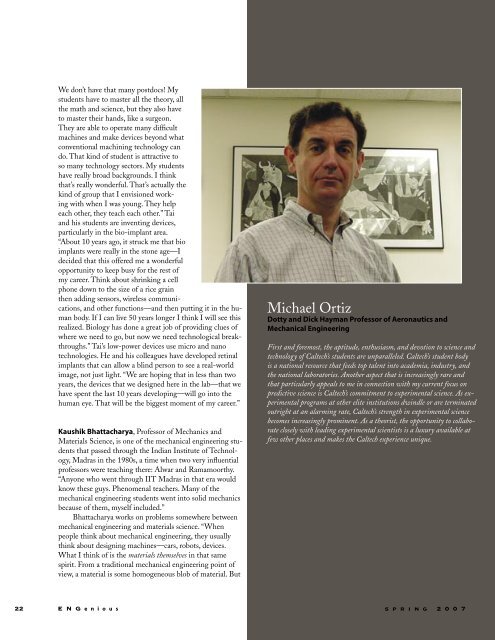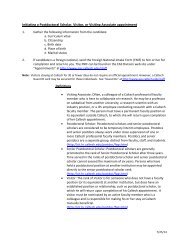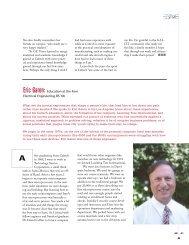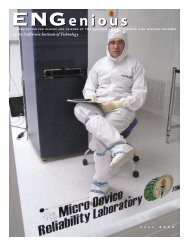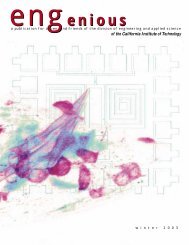Issue No.6 PDF (3 MB) - Division of Engineering and Applied Science
Issue No.6 PDF (3 MB) - Division of Engineering and Applied Science
Issue No.6 PDF (3 MB) - Division of Engineering and Applied Science
Create successful ePaper yourself
Turn your PDF publications into a flip-book with our unique Google optimized e-Paper software.
We don’t have that many postdocs! My<br />
students have to master all the theory, all<br />
the math <strong>and</strong> science, but they also have<br />
to master their h<strong>and</strong>s, like a surgeon.<br />
They are able to operate many difficult<br />
machines <strong>and</strong> make devices beyond what<br />
conventional machining technology can<br />
do. That kind <strong>of</strong> student is attractive to<br />
so many technology sectors. My students<br />
have really broad backgrounds. I think<br />
that’s really wonderful. That’s actually the<br />
kind <strong>of</strong> group that I envisioned working<br />
with when I was young. They help<br />
each other, they teach each other.” Tai<br />
<strong>and</strong> his students are inventing devices,<br />
particularly in the bio-implant area.<br />
“About 10 years ago, it struck me that bio<br />
implants were really in the stone age—I<br />
decided that this <strong>of</strong>fered me a wonderful<br />
opportunity to keep busy for the rest <strong>of</strong><br />
my career. Think about shrinking a cell<br />
phone down to the size <strong>of</strong> a rice grain<br />
then adding sensors, wireless communications,<br />
<strong>and</strong> other functions—<strong>and</strong> then putting it in the human<br />
body. If I can live 50 years longer I think I will see this<br />
realized. Biology has done a great job <strong>of</strong> providing clues <strong>of</strong><br />
where we need to go, but now we need technological breakthroughs.”<br />
Tai’s low-power devices use micro <strong>and</strong> nano<br />
technologies. He <strong>and</strong> his colleagues have developed retinal<br />
implants that can allow a blind person to see a real-world<br />
image, not just light. “We are hoping that in less than two<br />
years, the devices that we designed here in the lab—that we<br />
have spent the last 10 years developing—will go into the<br />
human eye. That will be the biggest moment <strong>of</strong> my career.”<br />
Kaushik Bhattacharya, Pr<strong>of</strong>essor <strong>of</strong> Mechanics <strong>and</strong><br />
Materials <strong>Science</strong>, is one <strong>of</strong> the mechanical engineering students<br />
that passed through the Indian Institute <strong>of</strong> Technology,<br />
Madras in the 1980s, a time when two very influential<br />
pr<strong>of</strong>essors were teaching there: Alwar <strong>and</strong> Ramamoorthy.<br />
“Anyone who went through IIT Madras in that era would<br />
know these guys. Phenomenal teachers. Many <strong>of</strong> the<br />
mechanical engineering students went into solid mechanics<br />
because <strong>of</strong> them, myself included.”<br />
Bhattacharya works on problems somewhere between<br />
mechanical engineering <strong>and</strong> materials science. “When<br />
people think about mechanical engineering, they usually<br />
think about designing machines—cars, robots, devices.<br />
What I think <strong>of</strong> is the materials themselves in that same<br />
spirit. From a traditional mechanical engineering point <strong>of</strong><br />
view, a material is some homogeneous blob <strong>of</strong> material. But<br />
Michael Ortiz<br />
Dotty <strong>and</strong> Dick Hayman Pr<strong>of</strong>essor <strong>of</strong> Aeronautics <strong>and</strong><br />
Mechanical <strong>Engineering</strong><br />
First <strong>and</strong> foremost, the aptitude, enthusiasm, <strong>and</strong> devotion to science <strong>and</strong><br />
technology <strong>of</strong> Caltech’s students are unparalleled. Caltech’s student body<br />
is a national resource that feeds top talent into academia, industry, <strong>and</strong><br />
the national laboratories. Another aspect that is increasingly rare <strong>and</strong><br />
that particularly appeals to me in connection with my current focus on<br />
predictive science is Caltech’s commitment to experimental science. As experimental<br />
programs at other elite institutions dwindle or are terminated<br />
outright at an alarming rate, Caltech’s strength in experimental science<br />
becomes increasingly prominent. As a theorist, the opportunity to collaborate<br />
closely with leading experimental scientists is a luxury available at<br />
few other places <strong>and</strong> makes the Caltech experience unique.<br />
22 E N G e n i o u s<br />
s p r i n g 2 0 0 7


